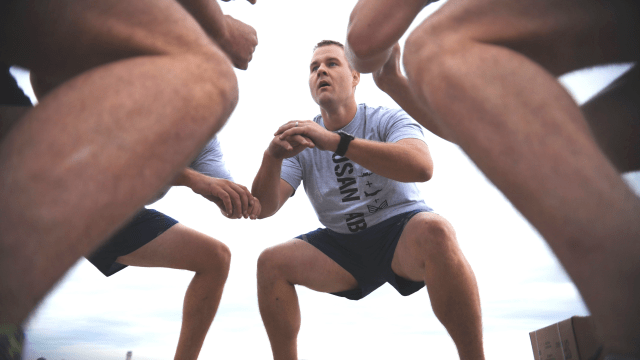Squatting seems so complicated when somebody is telling you all the things that can go wrong — knees behind toes! Butt farther down! Head up! But not too up! If you’re following our challenge, you’re probably doing a lot more squats than you ever have before, so let’s talk about how we’re doing them.
You should of course get advice from a trainer, coach, or experienced friend who knows what they’re doing; a few articles such as this one are not enough to fully teach you to squat. But here are a few of the things you might hear from a good trainer, and why they’re worth paying attention to:
Your Knees Don’t Always Have to Stay Behind Your Toes
There is a popular rule that says your knees should never go forward of your toes (as viewed in a mirror) when you squat. I dug into the history of this rule once, and it turned out it came from a study of (successful, uninjured) weightlifters.
They probably weren’t thinking about their knee position, but some had their knees go in front of their toes and some didn’t. The researchers calculated that those whose knees stayed behind their toes should have less stress on their knees.
But that doesn’t mean something is wrong if your knees go a little forward; it may just be how your body is built. Most coaches today will tell you this “rule” doesn’t matter if your form is otherwise good.
If your body naturally wants to put your knees in front of your toes, restricting that motion — for example, by squatting in front of a wall — can actually cause you to change other aspects of your form, such as sticking your butt out so far behind you that you’re putting extra stress on your back.
Don’t Let Your Knees Cave In, Though
Do some squats facing a mirror (or take a video or have a friend watch you). Ideally your legs should stay parallel to each other during the movement, without your knees caving in.
If they are caving in, it’s often because your leg muscles just aren’t strong enough to keep your knees stable.
To fix this, do whatever squats you can, but think about keeping your knees wide, as if you’re pressing them out to the sides. Maybe you can’t go down very far this way, or maybe you can’t use as much weight as you’d like if you’re doing these squats with weight. Back off and take the time to do these squats right. Soon you’ll be strong enough to squat deeper and heavier without your knees collapsing.
How Low Should You Go?
As low as you can with good form. If something hurts when you try to squat “arse to grass”, don’t do that. (Do consider working with a trainer to figure out what’s wrong. Maybe your body just isn’t built to go that low, or maybe you could achieve that depth if you work on a few things first.)
If you’re a beginner and you can only go down a few centimetres before your form starts to fall apart, then just squat those few centimetres (and maybe try some of these beginner friendly movements instead or in addition).
Have you been struggling with your squat form these past few weeks? Or has everything been going great and you’re moving on to more reps and more weight? Talk about it in the comments. But please remember that online discussions aren’t a replacement for in-person advice from a qualified professional.

Comments